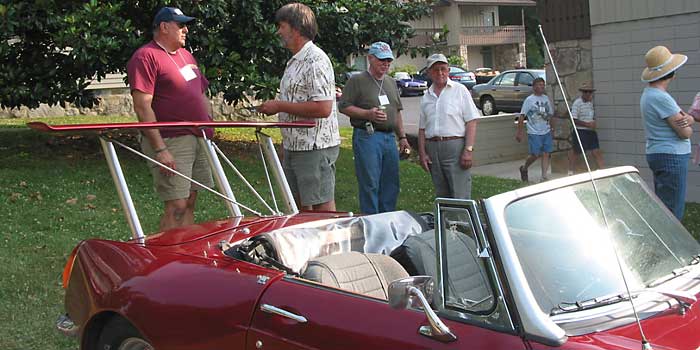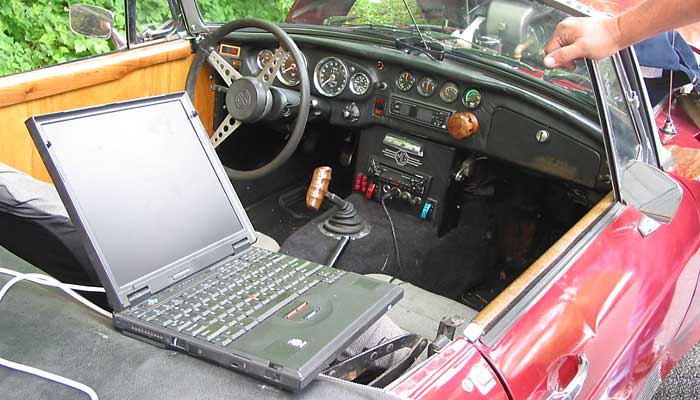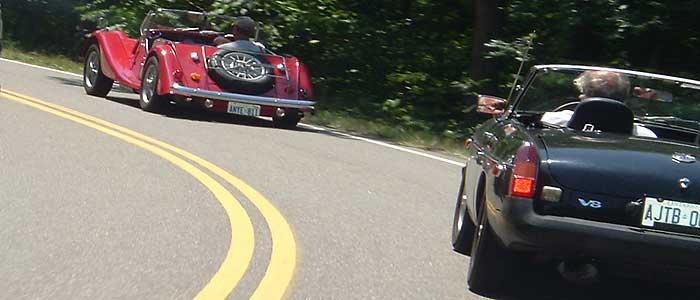
Bill Guzman and Jim Blackwood discuss engine tuning and performance at British V8 2006,
while Jack Renaud and Ken Costello consider Jim's Supercharged / Injected Olds 215 MGB
Tuning for Temperature Control
as published in British V8 Newsletter, Volume XIV Issue 2, August 2006by: Jim Blackwood
The 2006 British V8 show was the scene of much creative thinking about our collective
passion and nowhere was that more needed than in the arena of engine cooling, which
continues to be an Achilles Heel of the sport. But this may soon change. It is my
intention in this article to encapsulate the thinking of some of our most knowledgeable
members on the topic and concentrate on an aspect which on one hand is certainly not
revolutionary, but on the other is usually overlooked in our tuning efforts: tuning
for engine temperature control.
Tuning is done to satisfy many demands. We tune for power, economy, driveability, and
emissions control though not always in that order, but seldom consider what we are doing
to our heat management in the process. Partly this is because one usually follows along
well enough with the other that we needn't consider it, and partly because we don't
understand it very well. But to follow on after the very capable work of Bill Guzman at
the meet on the topic of vacuum tuning for idle control and responsiveness, we find that
some of the very same techniques can be used in tuning for cooling as well.
Before I go further, perhaps it's best to note that engine temp control also encompasses keeping adequate heat in the engine as well as removing excess heat, so with that in mind let's look at two major topics, those being fuel control and timing control. As noted by Bill in his tech session address, mixture control is essential to engine temperature control. We've all heard that a rich mixture burns cooler and a lean mixture burns hotter but most of us have no concept of what that means in real life terms so I'll try to provide an example: I'm fortunate enough to now have the means of accurately controlling and tuning the mixture from the driver's seat, and of monitoring not just the coolant temp but the exhaust temp and a few other factors as well. Towards the end of several hour's drive to the meet, I found myself climbing Jellico Hill on I-75 at the KY/TN border or near thereabouts. Some would call Jellico a mountain. I'd be tempted to as well, being from WV, but I know quite well our western members would scoff at the idea. However it is certainly a decent sized hill with long up and down grades. So in the process of climbing the northern approach I was watching the coolant temp climb with a bit of concern, as it was climbing rapidly and I had no hope of making the top before it rose unacceptably high. Help was at hand however in the form of an old IBM laptop and a fuel injection controller called MegaSquirt. Like most good aftermarket EFI systems, this one included a fuel map with the ability to make adjustments and control the mixture "on the fly" with the car running, so bringing up the appropriate map I began to enrichen the mixture, specifically in the general vicinity of the RPM's and manifold pressure that the engine was running while climbing the hill. This is rather easily done by the use of a dot on the map which positions itself at the rpm and manifold pressure the engine is instantaneously running and does so continuously, and by the use of an "X" or cursor which can be controlled with the arrow keys, or can be made to follow the dot around the map like a little puppy, positioning itself at the closest place to the dot that the grid lines cross. By simply pressing one key ("Q") for "richer" and another ("W") for "leaner" the puppy - er, I mean the intersection the cursor is sitting on, can be made to go up or down, making the mixture richer or leaner.

Data acquisition, analysis, and action! Jim adjusts ignition advance and MegaSquirt fuel injection maps on-the-fly.
So I began to richen up the mixture. Now I'm also fortunate enough to have a recently installed wideband oxygen sensor, so I could get immediate feedback as to what mixture was actually reaching the engine. As we know stoichiometric is 14.7:1 and means a chemically balanced mixture and anything below 14.7 is rich and above it is lean. So starting with a mixture that was balanced, I began to work my way down into the 14's and then on down into the high to mid 13's and as I did so I could watch the rise of the temperature gage slow, come to a halt, and finally begin to recede. As it dropped back into the vicinity of 212 degrees and below I became very happy with my tuning efforts, but rather than get too much of a good thing going I stopped richening the mix and proceeded on up the hill, rather pleased that the trick had done so well.
|
Enjoying this article? Our magazine is funded through the generous support of readers like you! To contribute to our operating budget, please click here and follow the instructions. (Suggested contribution is twenty bucks per year. Feel free to give more!) |
That is, until I got to the top and began down the other side. This was when I discovered
that there was a bit more to the process, as engine temperature just kept right on going
down until it was hovering around 165 degrees. Now 165 is not all that bad, lots of us
would be tickled to see 165. But my EFI controller didn't like it a bit and began to kick
in the warm-up enrichments, which to say the least was wasteful of fuel, so something had
to be done. It so happens that going downhill although the engine is going the same speed
as going up it has the throttle closed more and so has less manifold pressure and the dot
dances around a different area of the map. So I sent the puppy there - the "X" I mean -
and began to lean out that section to see if I could warm up the engine. This ploy also
worked and soon I was holding a pretty stable 180 degrees on the downhill with the mixture
somewhere in the 15:1 range, in the yellow. The gage face turns red at 16:1 so I tried to
stay above that. And this worked very well until we got into Maryville and slow traffic.
Here, once again the car began to heat up and once again it was the rich mixture to the
rescue, and once again in a different area of the map. On into the meet then, everything
under control and happy results all around. Except fuel economy could have been better.
However the point being made here is that the fuel mixture is capable of giving very
substantial, valuable, and usable control over the engine temperature. Not only that, but
it is mostly complimentary to the goal of maximizing power output. Climbing the hill we
needed a rich mixture for cooling. For climbing we also need power, and power production
likes a rich mixture as well. Coasting down, a lean mix helped keep the engine warm and
economy likes a lean mix. The only contrary part seemed to be around town at slow speed,
but there is some small benefit in a rich mixture to overcome stalling tendencies so that
is offset to a small degree. As for leaving the job of keeping the engine warm to the
thermostat, more on that later. And I don't mean to convey the idea that any ill may be
cured by controlling the mixture. Far from it, it is just one tool in the arsenal. But it
turns out to be a pretty potent one.
Still we can't stop here for it is quite apparent that if this much can be done with
mixture control then more can be done with timing control, and indeed this is the case.
Again, using Jellico hill and the trip home as a testing run, I found that an increase
in total timing advance at highway speeds from approximately 38 degrees up to 41 made an
immediate difference in engine temperature, as well as Exhaust Gas Temperature (EGT),
bringing the EGT down 150 degrees and the coolant temp down to 170 and holding it there.
I then began to lean the mixture back out, ultimately reaching ratios in the low to mid
15's at cruising speeds without any increase in the coolant temp. At 16:1 lean
misfire began to occur so I backed it away from that precipice. At this point, getting
regular hits on the warm-up enrichment I decided to disable warm-up at anything above
140 and this further smoothed out the engine and at last the coolant temp rose slightly
into the 170-180 range. Now the EGT was a different matter, as it did climb as I leaned
out the mixture, coming up 200 degrees or so to just under 900 (my thermocouple is mounted
just after the collector) but still acceptable.
This was all before I reached Jellico hill, and by the time I got there I was running as
just mentioned and pulling between 14 and 18 inches of vacuum as we were ascending the hill.
All looked very good at this point and I let the laptop blank out and rest a bit, relying
on the dashboard gages and for most of the rest of the trip the temps pretty well stayed
down with the exception of a couple of hard bursts of acceleration, which caused temps to
come up more quickly than I would have liked, but they went back down pretty well too. By
1:00 we had reached Florence, KY and were running 190 degrees. Fuel mileage had improved
noticeably, and I felt I now had the tools to prevent overheating if I used them properly.
I had demonstrated that mixture control had the potential to compensate for insufficient
timing in a noticeable way and I had demonstrated also that timing had the ability to
overcome the heating effects of a lean mixture.

How does Dave Burstyn's MGB V8 keep its cool, even with its stock MGB radiator? Keep Reading!
Now it was just a matter of finding the proper amounts of both, and here we go back to the vacuum idle adjustment techniques. In that tuning process first the timing is set to optimize vacuum and then idle mixture is adjusted to do the same. But in the typical adjustment the timing is distributor-controlled which means it is set by a fixed mechanical curve and a vacuum curve. There is a range where the curves combine of course which roughly corresponds to the 3D timing map used above but it is difficult to tailor the curve so usually initial timing is set and sometimes the mechanical curve is adjustable. With the vacuum setting of the engine timing being done as it is at 2000rpm, it is set at some point in that curve, after advance has begun to come in but before it has reached maximum. Also, as it is done with the idle screw run in to bring up the engine speed and with no load, vacuum advance is at maximum. This is all fine of course but the point is that timing is set at optimum at one point in the curve and if the curve does not exactly match the engine that is probably the only point at which it is optimized. If we are timing for heat control we probably want optimal timing at idle and speeds just off idle for in-town driving, and then again at cruising speed and light loads for economy, and finally under heavy loads at all speeds for power, to say nothing at all of partial throttle settings under significant loads. Without a dyno and a distributor machine, setting up a distributor to do that correctly for any given engine is a bit of a crap shoot, but with careful use of the vacuum gage and the appropriate techniques I have no doubt that the members of this group can accomplish it.
So following the vacuum tuning process further, having gotten the timing curve as close as
possible in those three areas we can now tune the mixture for power, economy, and temperature
control by paying careful attention to what affects those areas. Obviously with EFI it is
pretty simple as you simply go to the relevant area of the map, but what about carbs? The
power area is pretty easy. As the main jets are adjusted for maximum acceleration and the
A/F ratio dips into the 13:1 region optimal cooling by mixture control will follow along
and there will be some leeway for additional cooling by going richer than the optimal mixture
without affecting power. The intermediate controls should correlate primarily to the economy
range, with some overlap into low speed operation, and idle settings can be made richer to
help cooling as well at low speeds. It's not optimal and a great deal depends on how the
intermediate circuits, air bleeds, and overlap areas are set up in the particular carb but
a tolerable compromise should be possible in most cases.
But like I said to start with, none of this is really new. We've set up carbs this way forever.
On a practical note, what comes of this experiment is just this: the key seems to be the ignition
timing, and more specifically the amount of total advance at those times when the engine most
needs help in controlling heat. Collectively we've done everything that can be done in terms of
radiators and fans and found, oddly enough, in some cases it simply isn't enough. In other cases
special radiators just aren't necessary. How do we account for the guy who does just fine with a
stock MGB radiator or a 2 row American OEM one? Well we are not dealing with rocket science here.
My postulate is just this simple: those guys get by with it because their DISTRIBUTOR is properly
matched to their engine. Those of us who have cooling problems have them because of the exact
opposite reason. We've modified our engines, intake and exhaust systems but we haven't tuned our
timing advance to match. If we will take the trouble to do that in whatever way is most appropriate
it is my belief that our heat problems will for the most part simply dissipate.
Disclaimer: This page was researched and written by Jim Blackwood. Views expressed
are those of the author, and are provided without warrantee or guarantee. Apply at your
own risk.
Photos (#1 and #2) by Curtis Jacobson and (#3) by Greg Myers. All rights reserved.
Note: If you like this article, you'll probably also like
"Cooling System Design Considerations" by Curtis Jacobson.

